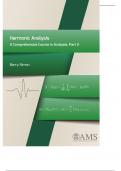Harmonic Analysis
A Comprehensive Course in Analysis, Part 3
Barry Simon
,Harmonic Analysis
A Comprehensive Course in Analysis, Part 3
,
, http://dx.doi.org/10.1090/simon/003
Harmonic Analysis
A Comprehensive Course in Analysis, Part 3
Barry Simon
Providence, Rhode Island
, 2010 Mathematics Subject Classification. Primary 26-01, 31-01, 46-01;
Secondary 30H10, 30H35, 42C40, 42B20, 46E35.
For additional information and updates on this book, visit
www.ams.org/bookpages/simon
Library of Congress Cataloging-in-Publication Data
Simon, Barry, 1946–
Harmonic analysis / Barry Simon.
pages cm. — (A comprehensive course in analysis ; part 3)
Includes bibliographical references and indexes.
ISBN 978-1-4704-1102-2 (alk. paper)
1. Mathematical analysis—Textbooks. 2. Harmonic analysis—Textbooks. I. Title.
QA300.S5275 2015
515�.2433—dc23
2015024457
Copying and reprinting. Individual readers of this publication, and nonprofit libraries
acting for them, are permitted to make fair use of the material, such as to copy select pages for
use in teaching or research. Permission is granted to quote brief passages from this publication in
reviews, provided the customary acknowledgment of the source is given.
Republication, systematic copying, or multiple reproduction of any material in this publication
is permitted only under license from the American Mathematical Society. Permissions to reuse
portions of AMS publication content are handled by Copyright Clearance Center’s RightsLink�
service. For more information, please visit: http://www.ams.org/rightslink.
Send requests for translation rights and licensed reprints to reprint-permission@ams.org.
Excluded from these provisions is material for which the author holds copyright. In such cases,
requests for permission to reuse or reprint material should be addressed directly to the author(s).
Copyright ownership is indicated on the copyright page, or on the lower right-hand corner of the
first page of each article within proceedings volumes.
�
c 2015 by the American Mathematical Society. All rights reserved.
The American Mathematical Society retains all rights
except those granted to the United States Government.
Printed in the United States of America.
�
∞ The paper used in this book is acid-free and falls within the guidelines
established to ensure permanence and durability.
Visit the AMS home page at http://www.ams.org/
10 9 8 7 6 5 4 3 2 1 20 19 18 17 16 15
, To the memory of Cherie Galvez
extraordinary secretary, talented helper, caring person
and to the memory of my mentors,
Ed Nelson (1932-2014) and Arthur Wightman (1922-2013)
who not only taught me Mathematics
but taught me how to be a mathematician
,
,Contents
Preface to the Series xi
Preface to Part 3 xvii
Chapter 1. Preliminaries 1
§1.1. Notation and Terminology 1
§1.2. Some Results for Real Analysis 3
§1.3. Some Results from Complex Analysis 12
§1.4. Green’s Theorem 16
Chapter 2. Pointwise Convergence Almost Everywhere 19
§2.1. The Magic of Maximal Functions 22
§2.2. Distribution Functions, Weak-L1 , and Interpolation 26
§2.3. The Hardy–Littlewood Maximal Inequality 41
§2.4. Differentiation and Convolution 52
§2.5. Comparison of Measures 60
§2.6. The Maximal and Birkhoff Ergodic Theorems 65
§2.7. Applications of the Ergodic Theorems 92
§2.8. Bonus Section: More Applications of the Ergodic
Theorems 102
§2.9. Bonus Section: Subadditive Ergodic Theorem and
Lyapunov Behavior 133
§2.10. Martingale Inequalities and Convergence 147
§2.11. The Christ–Kiselev Maximal Inequality and Pointwise
Convergence of Fourier Transforms 168
vii
,viii Contents
Chapter 3. Harmonic and Subharmonic Functions 173
§3.1. Harmonic Functions 177
§3.2. Subharmonic Functions 202
§3.3. Bonus Section: The Eremenko–Sodin Proof of Picard’s
Theorem 213
§3.4. Perron’s Method, Barriers, and Solution of the Dirichlet
Problem 220
§3.5. Spherical Harmonics 232
§3.6. Potential Theory 252
§3.7. Bonus Section: Polynomials and Potential Theory 278
§3.8. Harmonic Function Theory of Riemann Surfaces 298
Chapter 4. Bonus Chapter: Phase Space Analysis 319
§4.1. The Uncertainty Principle 320
§4.2. The Wavefront Sets and Products of Distributions 345
§4.3. Microlocal Analysis: A First Glimpse 352
§4.4. Coherent States 373
§4.5. Gabor Lattices 390
§4.6. Wavelets 407
Chapter 5. H p Spaces and Boundary Values of Analytic Functions
on the Unit Disk 437
§5.1. Basic Properties of Hp 439
§5.2. H2 444
§5.3. First Factorization (Riesz) and Hp 450
§5.4. Carathéodory Functions, h1 , and the Herglotz
Representation 459
§5.5. Boundary Value Measures 464
§5.6. Second Factorization (Inner and Outer Functions) 468
§5.7. Conjugate Functions and M. Riesz’s Theorem 472
§5.8. Homogeneous Spaces and Convergence of Fourier Series 493
§5.9. Boundary Values of Analytic Functions in the Upper
Half-Plane 498
§5.10. Beurling’s Theorem 515
§5.11. H p -Duality and BMO 517
§5.12. Cotlar’s Theorem on Ergodic Hilbert Transforms 539
, Contents ix
Chapter 6. Bonus Chapter: More Inequalities 543
§6.1. Lorentz Spaces and Real Interpolation 547
§6.2. Hardy-Littlewood–Sobolev and Stein–Weiss Inequalities 559
§6.3. Sobolev Spaces; Sobolev and Rellich–Kondrachov
Embedding Theorems 565
§6.4. The Calderón–Zygmund Method 588
§6.5. Pseudodifferential Operators on Sobolev Spaces and the
Calderón–Vaillancourt Theorem 604
§6.6. Hypercontractivity and Logarithmic Sobolev Inequalities 615
§6.7. Lieb–Thirring and Cwikel–Lieb–Rosenblum Inequalities 657
§6.8. Restriction to Submanifolds 671
§6.9. Tauberian Theorems 686
Bibliography 691
Symbol Index 737
Subject Index 739
Author Index 751
Index of Capsule Biographies 759




